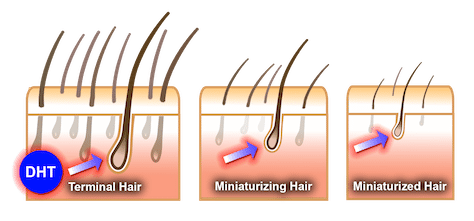DHT is a term that comes up frequently when people discuss male pattern baldness. The purpose of this article is to explain what DHT is and how it causes hair loss.
DHT is short for “Dihydrotestosterone”, and is essentially a male sex hormone (androgen). DHT is formed when the 5a reductase enzyme synthesizes DHT in the body’s adrenal glands, prostate, testes, and hair follicles. It is also important to note that changes in the metabolic function and production of various androgens, such as DHT, can have a severe impact on hair loss in both men and women, although men are more likely to be affected as they produce more testosterone than women.
The most common form of hair loss is known as androgenetic alopecia, or male pattern baldness. The same term can be used to describe genetic-based-or hereditary-hair loss in women, known as female pattern baldness. Both forms of baldness have the same cause; DHT. DHT causes male and female pattern baldness by causing hair follicles to shrink. Hair follicles are generally quite sensitive, and increased exposure to DHT caused a process known as miniaturization. The result is abnormal hair formation, with the lifespan of hairs become shorter and the hairs themselves become thinner and thinner until they stop forming altogether.

To go into greater detail, the dermal papilla is the most important component of hair follicles. In fact, it is directly responsible for new hair growth. The cells in the dermal papilla differentiate and divide in order to create new hair follicles. The papilla is also in contact with the blood capillaries in the body. The blood capillaries are responsible for sending vital nutrients that are required for hair follicles to grow properly.
In addition, the dermal papilla also has several androgen receptors, although men have more androgen receptors than women. In regards to DHT, it can directly attach itself to the androgen receptors and prevent them from absorbing the essential nutrients required for health hair follicles to form. If DHT is not removed, then the hair resting stages will become longer and the hair growth stages will become shorter; leading to total baldness if left untreated.
Submit your review | |
